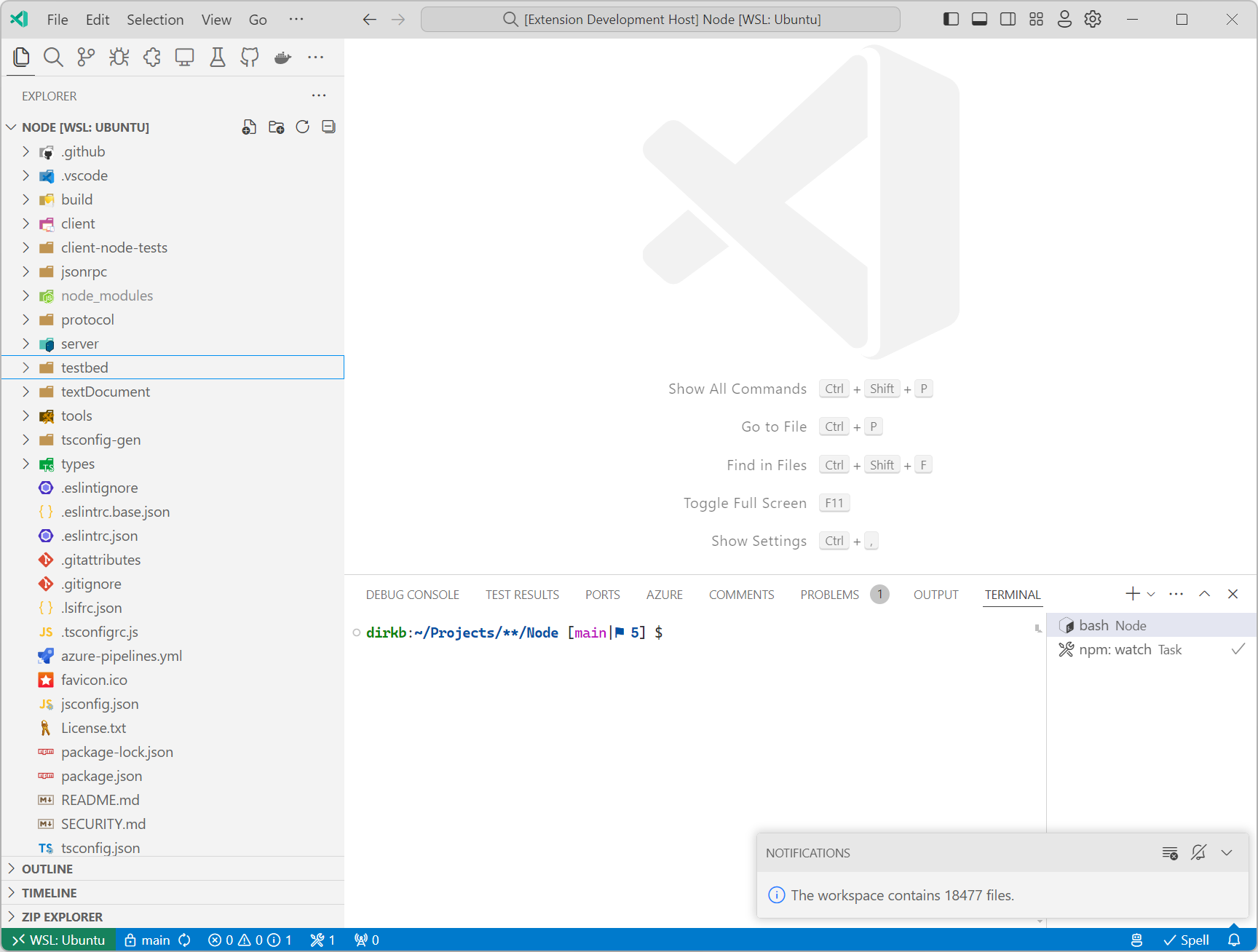使用 WebAssembly 进行扩展开发 - 第二部分
2024年6月7日,作者:Dirk Bäumer
在上一篇关于使用 WebAssembly 进行扩展开发的博客文章中,我们演示了如何使用组件模型将 WebAssembly 代码集成到您的 Visual Studio Code 扩展中。在这篇博客文章中,我们重点关注两个额外的独立用例:(a)在工作线程中运行 WebAssembly 代码,以避免阻塞扩展主机的主线程,以及(b)使用可编译为 WebAssembly 的语言创建语言服务器。
要运行本博客文章中的示例,您需要以下工具:VS Code、Node.js、Rust 编译器工具链、wasm-tools 和 wit-bindgen。
在工作线程中执行 WebAssembly 代码
上一篇博客文章中的示例在 VS Code 扩展主机的主线程中运行 WebAssembly 代码。只要执行时间短,这是可以的。但是,长时间运行的操作应该在工作线程中执行,以确保扩展主机主线程对其他扩展保持可用。
VS Code 组件模型提供了一个元模型,通过使我们能够在工作线程和扩展主线程两侧自动生成必要的粘合代码来简化这一点。
以下代码片段显示了工作线程所需的代码。该示例假设代码存储在名为worker.ts的文件中。
import { Connection, RAL } from '@vscode/wasm-component-model';
import { calculator } from './calculator';
async function main(): Promise<void> {
const connection = await Connection.createWorker(calculator._);
connection.listen();
}
main().catch(RAL().console.error);
此代码创建一个连接以与扩展主机主工作线程通信,并使用由wit2ts工具生成的calculator世界初始化连接。
在扩展端,我们加载 WebAssembly 模块并将其绑定到calculator世界。执行计算的相应调用需要等待,因为执行在工作线程中异步进行(例如,await api.calc(...))。
// The channel for printing the result.
const channel = vscode.window.createOutputChannel('Calculator');
context.subscriptions.push(channel);
// The channel for printing the log.
const log = vscode.window.createOutputChannel('Calculator - Log', { log: true });
context.subscriptions.push(log);
// The implementation of the log function that is called from WASM
const service: calculator.Imports.Promisified = {
log: async (msg: string): Promise<void> => {
// Wait 100ms to slow things down :-)
await new Promise(resolve => setTimeout(resolve, 100));
log.info(msg);
}
};
// Load the WASM model
const filename = vscode.Uri.joinPath(
context.extensionUri,
'target',
'wasm32-unknown-unknown',
'debug',
'calculator.wasm'
);
const bits = await vscode.workspace.fs.readFile(filename);
const module = await WebAssembly.compile(bits);
// Create the worker
const worker = new Worker(
vscode.Uri.joinPath(context.extensionUri, './out/worker.js').fsPath
);
// Bind the world to the worker
const api = await calculator._.bind(service, module, worker);
vscode.commands.registerCommand(
'vscode-samples.wasm-component-model-async.run',
async () => {
channel.show();
channel.appendLine('Running calculator example');
const add = Types.Operation.Add({ left: 1, right: 2 });
channel.appendLine(`Add ${await api.calc(add)}`);
const sub = Types.Operation.Sub({ left: 10, right: 8 });
channel.appendLine(`Sub ${await api.calc(sub)}`);
const mul = Types.Operation.Mul({ left: 3, right: 7 });
channel.appendLine(`Mul ${await api.calc(mul)}`);
const div = Types.Operation.Div({ left: 10, right: 2 });
channel.appendLine(`Div ${await api.calc(div)}`);
}
);
有几个重要事项需要注意:
- 此示例中使用的 WIT 文件与上一篇博客文章中计算器示例使用的文件没有区别。
- 由于 WebAssembly 代码的执行发生在工作线程中,因此导入服务的实现(例如,上面的
log函数)可以返回一个Promise,但不是必须的。 - WebAssembly 目前只支持同步执行模型。因此,从执行 WebAssembly 代码的工作线程到扩展主机主线程以调用导入服务的每次调用都需要以下步骤:
- 向扩展主机主线程发送一条消息,描述要调用的服务(例如,调用
log函数)。 - 使用
Atomics.wait暂停工作线程执行。 - 在扩展主机主线程中处理消息。
- 使用
Atomics.notify恢复工作线程并通知它结果。
- 向扩展主机主线程发送一条消息,描述要调用的服务(例如,调用
这种同步增加了可测量的额外时间开销。尽管所有这些步骤都由组件模型透明地处理,但开发人员应该意识到它们,并在设计导入的 API 表面时考虑这一点。
您可以在VS Code 扩展示例仓库中找到此示例的完整源代码。
基于 WebAssembly 的语言服务器
当我们开始为Web 版 VS Code 提供 WebAssembly 支持时,我们设想的用例之一是使用 WebAssembly 执行语言服务器。随着 VS Code 的 LSP 库的最新更改以及引入了一个新模块来桥接 WebAssembly 和 LSP,实现 WebAssembly 语言服务器现在就像实现操作系统进程一样简单。
此外,WebAssembly 语言服务器运行在WebAssembly 核心扩展上,该扩展完全支持 WASI Preview 1。这意味着语言服务器可以使用其编程语言的常规文件系统 API 访问工作区中的文件,即使文件是远程存储的,例如在 GitHub 仓库中。
以下代码片段展示了一个基于lsp_server crate 的示例服务器的 Rust 语言服务器。此语言服务器不执行任何语言分析,只是为GotoDefinition请求返回预定义的结果:
match cast::<GotoDefinition>(req) {
Ok((id, params)) => {
let uri = params.text_document_position_params.text_document.uri;
eprintln!("Received gotoDefinition request #{} {}", id, uri.to_string());
let loc = Location::new(
uri,
lsp_types::Range::new(lsp_types::Position::new(0, 0), lsp_types::Position::new(0, 0))
);
let mut vec = Vec::new();
vec.push(loc);
let result = Some(GotoDefinitionResponse::Array(vec));
let result = serde_json::to_value(&result).unwrap();
let resp = Response { id, result: Some(result), error: None };
connection.sender.send(Message::Response(resp))?;
continue;
}
Err(err @ ExtractError::JsonError { .. }) => panic!("{err:?}"),
Err(ExtractError::MethodMismatch(req)) => req,
};
您可以在VS Code 示例仓库中找到语言服务器的完整源代码。
您可以使用新的@vscode/wasm-wasi-lsp npm 模块在扩展的 TypeScript 代码中创建 WebAssembly 语言服务器。通过使用WebAssembly 核心扩展将 WebAssembly 代码实例化为一个支持 WASI 的工作线程,这在我们的在 Web 版 VS Code 中运行 WebAssembly 博客文章中有详细描述。
扩展的 TypeScript 代码也很简单。它为纯文本文件注册服务器。
import {
createStdioOptions,
createUriConverters,
startServer
} from '@vscode/wasm-wasi-lsp';
export async function activate(context: ExtensionContext) {
const wasm: Wasm = await Wasm.load();
const channel = window.createOutputChannel('LSP WASM Server');
// The server options to run the WebAssembly language server.
const serverOptions: ServerOptions = async () => {
const options: ProcessOptions = {
stdio: createStdioOptions(),
mountPoints: [{ kind: 'workspaceFolder' }]
};
// Load the WebAssembly code
const filename = Uri.joinPath(
context.extensionUri,
'server',
'target',
'wasm32-wasip1-threads',
'release',
'server.wasm'
);
const bits = await workspace.fs.readFile(filename);
const module = await WebAssembly.compile(bits);
// Create the wasm worker that runs the LSP server
const process = await wasm.createProcess(
'lsp-server',
module,
{ initial: 160, maximum: 160, shared: true },
options
);
// Hook stderr to the output channel
const decoder = new TextDecoder('utf-8');
process.stderr!.onData(data => {
channel.append(decoder.decode(data));
});
return startServer(process);
};
const clientOptions: LanguageClientOptions = {
documentSelector: [{ language: 'plaintext' }],
outputChannel: channel,
uriConverters: createUriConverters()
};
let client = new LanguageClient('lspClient', 'LSP Client', serverOptions, clientOptions);
await client.start();
}
运行代码会在纯文本文件的上下文菜单中添加一个“转到定义”条目。执行此操作会向 LSP 服务器发送相应的请求。

需要注意的是,@vscode/wasm-wasi-lsp npm 模块会自动将文档 URI 从其工作区值转换为 WASI Preview 1 主机中识别的值。在上面的示例中,VS Code 中文本文档的 URI 通常是vscode-vfs://github/dbaeumer/plaintext-sample/lorem.txt,此值将转换为file:///workspace/lorem.txt,后者在 WASI 主机中被识别。当语言服务器将 URI 发送回 VS Code 时,此转换也会自动发生。
大多数语言服务器库都支持自定义消息,这使得添加语言服务器协议规范中尚未存在的功能变得容易。以下代码片段展示了如何为我们之前使用的 Rust 语言服务器添加一个自定义消息处理程序,用于计算给定工作区文件夹中的文件:
#[derive(Debug, Eq, PartialEq, Clone, Deserialize, Serialize)]
#[serde(rename_all = "camelCase")]
pub struct CountFilesParams {
pub folder: Url,
}
pub enum CountFilesRequest {}
impl Request for CountFilesRequest {
type Params = CountFilesParams;
type Result = u32;
const METHOD: &'static str = "wasm-language-server/countFilesInDirectory";
}
//...
for msg in &connection.receiver {
match msg {
//....
match cast::<CountFilesRequest>(req) {
Ok((id, params)) => {
eprintln!("Received countFiles request #{} {}", id, params.folder);
let result = count_files_in_directory(¶ms.folder.path());
let json = serde_json::to_value(&result).unwrap();
let resp = Response { id, result: Some(json), error: None };
connection.sender.send(Message::Response(resp))?;
continue;
}
Err(err @ ExtractError::JsonError { .. }) => panic!("{err:?}"),
Err(ExtractError::MethodMismatch(req)) => req,
}
}
//...
}
fn count_files_in_directory(path: &str) -> usize {
WalkDir::new(path)
.into_iter()
.filter_map(Result::ok)
.filter(|entry| entry.file_type().is_file())
.count()
}
发送此自定义请求到 LSP 服务器的 TypeScript 代码如下:
const folder = workspace.workspaceFolders![0].uri;
const result = await client.sendRequest(CountFilesRequest, {
folder: client.code2ProtocolConverter.asUri(folder)
});
window.showInformationMessage(`The workspace contains ${result} files.`);
在vscode-languageserver仓库上运行此操作会显示以下通知:

请注意,语言服务器不一定需要实现语言服务器协议规范中指定的任何功能。如果扩展想要集成只能编译到 WASI Preview 1 目标的库代码,那么在 VS Code 的组件模型实现支持 WASI 0.2 预览版之前,使用自定义消息实现语言服务器可能是一个不错的选择。
下一步是什么
正如上一篇博客文章中提到的,我们将继续努力为 VS Code 实现 WASI 0.2 预览版。我们还计划扩展代码示例,以包含除 Rust 以外的其他可编译为 WASM 的语言。
谢谢,
Dirk 和 VS Code 团队
编码愉快!